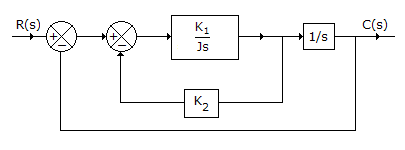ECE :: Automatic Control Systems
-
For the system in the given figure, the transfer function C(s)/R(s) is

-
For the system in the given figure, the characteristic equation is

-
In control systems the magnitude of error voltage
-
The slope of log-magnitude asymptote changes by - 40 dB/ decade at a frequency ω1. This means that
-
The transfer function
 can be for
can be for -
The system of the given figure

-
If phase angle of open loop transfer function becomes - 180° at frequency ω1, then gain margin is equal to


 Whatsapp
Whatsapp
 Facebook
Facebook


 .
.  .
. 






 there are two poles at s = -2 and s = -1 and one zero at s = +3.
there are two poles at s = -2 and s = -1 and one zero at s = +3.



 .
.

 . In this case gain is |G(jω1)|.
. In this case gain is |G(jω1)|.



